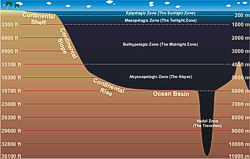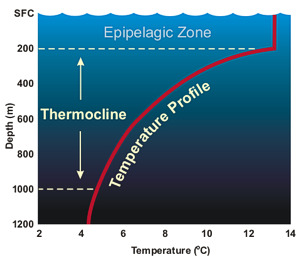|
Layers of the Ocean
 Just as the atmosphere is divided into layers the ocean consists of several layers itself. Just as the atmosphere is divided into layers the ocean consists of several layers itself.
- Epipelagic Zone
- This surface layer is also called the sunlight zone and extends from the surface to 660 feet (200 m). It is in this zone that most of the visible light exists. With the light comes heating from sun. This heating is responsible for wide change in temperature that occurs in this zone, both in the latitude and each season. The sea surface temperatures range from as high as 97°F (36°C) in the Persian Gulf to 28°F (-2°C) near the north pole.
The sea surface temperature also "follows the sun". From the earth's perspective, the sun's position in the sky moves higher each day from winter to summer and lower each day from summer to winter. This change in the sun's position from winter to summer means that more energy is reaching the ocean and therefore warms the water.
Following are several loops over various periods showing the north-south migration of temperature each month:
Interaction with the wind keeps this layer mixed and thus allows the heating from the sun to be distributed vertically. At the base of this mixing layer is the beginning of the thermocline. The thermocline is a region where water temperature decreases rapidly with increasing depth and transition layer between the mixed layer at the surface and deeper water.
 The depth and strength of the thermocline varies from season to season and year to year. It is strongest in the tropics and decrease to non-existent in the poler winter season. The depth and strength of the thermocline varies from season to season and year to year. It is strongest in the tropics and decrease to non-existent in the poler winter season.
- Mesopelagic Zone
- Below the epipelagic zone is the mesopelagic zone, extending from 660 feet (200 meters) to 3,300 feet (1,000 meters). The mesopelagic zone is sometimes referred to as the twilight zone or the midwater zone as sunlight this deep is very faint. Temperature changes the greatest in this zone as this is the zone with contains the thermocline.
Because of the lack of light, it is within this zone that bioluminescence begins to appear on life. The eyes on the fishes are larger and generally upward directed, most likely to see silhouettes of other animals (for food) against the dim light.
- Bathypelagic Zone
- The depths from 3,300 - 13,100 feet (1,000-4,000 meters) comprise the bathypelagic zone. Due to its constant darkness, this zone is also called the midnight zone. The only light at this depth (and lower) comes from the bioluminescence of the animals themselves.
The temperature in the bathypelagic zone, unlike that of the mesopelagic zone, is constant. The temperature never fluctuates far from a chilling 39°F (4°C). The pressure in the bathypelagic zone is extreme and at depths of 13,100 feet (4,000 meters), reaches over 5850 pounds per square inch! Yet, sperm whales can dive down to this level in search of food.
- Abyssopelagic Zone
- The Abyssopelagic Zone (or abyssal zone) extends from 13,100 feet (4,000 meters) to 19,700 feet (6,000 meters). It is the pitch-black bottom layer of the ocean. The name (abyss) comes from a Greek word meaning "no bottom" because they thought the ocean was bottomless. Three-quarters of the area of the deep-ocean floor lies in this zone. The water temperature is constantly near freezing and only a few creatures can be found at these crushing depths. The deepest a fish have ever been found was in the Puerto Rico Trench at 27,460 feet (8372 meters).
- Hadalpelagic Zone
- The deepest zone of the ocean, the hadalpelagic zone extends from 19,700 feet (6,000 meters) to the very bottom at 35,797 feet (10,911 meters) in the Mariana Trench off the coast of Japan. The temperature is constant at just above freezing. The weight of all the water over head in the Mariana Trench is over 8 tons per square inch (the weight of 48 Boeing 747 jets).
Even at the very bottom life exists. In 2005, tiny single-celled organisms, called foraminifera, a type of plankton, were discovered in the Challenger Deep trench southwest of Guam in the Pacific Ocean. |
| Next: Seawater |
|
National Weather Service
Southern Region Headquarters
819 Taylor Street
Fort Worth, Texas 76102 |
www.srh.weather.gov
Updated: March 29, 2006 |
|





